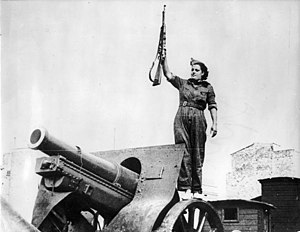Elatian Army: Difference between revisions
Arthurista (talk | contribs) m (→Origins) |
Arthurista (talk | contribs) m (→Origins) |
||
| Line 82: | Line 82: | ||
===Origins=== | ===Origins=== | ||
[[File:Strijdlustige vrouw - Woman ready to fight (3334194838).jpg|thumb| | [[File:Strijdlustige vrouw - Woman ready to fight (3334194838).jpg|thumb|left|300px|An Elatian gunner during the Second Belfro-Elatian War]] | ||
The first incarnation of the modern Elatian Army was the rebel warbands of [[Peter the Harbinger]], the 'Crazed Preacher' who led the oppressed peasants of the interior to overwhelm and destroy the league of coastal city states which had long exploited them, thereby founding the modern Blessed Republic. Throughout the history of Elatia, the country had to fight numerous wars with its neighbours, including two against Belfras beginning in 1853 and 1941 respectively, as well as twice against Enyama in 1904 and 1973. | The first incarnation of the modern Elatian Army was the rebel warbands of [[Peter the Harbinger]], the 'Crazed Preacher' who led the oppressed peasants of the interior to overwhelm and destroy the league of coastal city states which had long exploited them, thereby founding the modern Blessed Republic. Throughout the history of Elatia, the country had to fight numerous wars with its neighbours, including two against Belfras beginning in 1853 and 1941 respectively, as well as twice against Enyama in 1904 and 1973. | ||
Revision as of 18:57, 1 August 2021
| Commonwealth Army | |
|---|---|
 | |
| Active | 1847 (as the 'Blessed Army') |
| Country | Elatia |
| Branch | Army |
| Size | 365,676 (active), 877,000 (reserve) |
| Motto(s) | "Arise, oh ye Martyrs!" |
The Elatian Army is the ground warfare arm of the Elatian Armed Forces. As of 2021, it consists of some 360,000 troops under arms, making it one of the largest land forces in the world. It is charged with defending the Blessed Republic from its potentially hostile neighbours, in particular Belfras in the south, Enyama in the north and Gristol-Serkonos in the southeast.
The Elatian Army is not the sole land combat force in the Blessed Republic's service. Alongside the army, under the command of the Ministry of Defence, are the Elatian Airborne Corps and the Elatian Navy's Naval Infantry Corps. Similarly, under the Ecclesia's jurisdiction (and not the Ministry of Defence) are the Ecclesia Forces, primarily intended for the defence of the regime against internal enemies, as well as unconventional and political black operations abroad.
History
Origins
The first incarnation of the modern Elatian Army was the rebel warbands of Peter the Harbinger, the 'Crazed Preacher' who led the oppressed peasants of the interior to overwhelm and destroy the league of coastal city states which had long exploited them, thereby founding the modern Blessed Republic. Throughout the history of Elatia, the country had to fight numerous wars with its neighbours, including two against Belfras beginning in 1853 and 1941 respectively, as well as twice against Enyama in 1904 and 1973.
Late Twentieth Century
Subsequent to the end of the Second Belfro-Elatian War, the Elatia decided to adopt the policy of 'Purification by the Sword'. Its stated goal was the liberation of the world from the clutches of pro-Demiurge regimes, beginning with the Norumbian continent. Accordingly, it built up one of the largest armies the world has ever seen. Conscription terms ran to four years for men and two for women. At its height, in the early-1980's, the Elatian Army could count more than 100 divisions in its combined mobilisation strength, including reserve formations.
The major problem for Elatia during this period was its backwards technological and indusrial base, making it reliant upon the use of human wave tactics by its fanatical soldiery to overwhelm its enemies. Whilst the Prophet's Guard and a number of elite tank divisions had modern equipment and a reasonable level of professionalism, the remainder were, as a foreign observer described, "a vast peasant horde, tricked out with tanks". For example, the average infantry divisions would theoretically have six battalions of tanks, three concentrated in it organic tank regiment, and three distributed amongst its infantry regiments. In reality, most could only muster a single battalion under the divisional HQ's direct command. The infantry regiments themselves were supposed to be equipped with armoured personnel carriers. However, most had antiquated half-tracks if they were fortunate, and ordinary lorries (in Elatian slang, 'potato wagons') if they were not. The only weapon which was available in abundance was artillery pieces, and that was only because guns dating from the 1940's and even before were being issued to front-line forces alongside more modern specimen.
The Second Enyaman-Elatian War of 1973 threw the army's problems into sharp relief. A limited conflict lasting three weeks, it saw an Elatian tank division and an infantry division crossing the border to occupy a disputed town. The Enyaman Army, which had transformed itself into a force of mobile, combined arms combat groups in the preceding years, reacted much more swiftly than the Elatians anticipated. After a major tank battle, one of the largest since the Second Belfro-Elatian War, the tank division was in full retreat and the infantry division besieged, before the latter surrendered altogether after four days of urban combat.
Despite this humiliation, the army's organisation, training and doctrine remained largely unchanged in the subsequent years, largely as a result of institutional inertia, and partly because it was anticipated that the enormous Elatian numerical superiority, coupled with the deployment of weapons of mass destruction, would lead to ultimate victory in any full-scale war.
What finally led to fundamental change was not defeat in another war, but the economic collapse known as the Big Freeze in 1984. Unusual weather led to harvest failure, and the economy, weakened for years owing to a combination of agricultural collectivsation, poor centralised planning and ruinous military expenses, ceased to function overnight. It took a painful combination of free-market reforms, foreign aid and external investment before the economy managed to right itself in 1988.
Relative prosperity ensued in the 1990's. However, by this stage, the enormous conscript army of the 1970's had ceased to exist, in large part in order to free up labour for the rapidly growing economy. Most of the divisions which continued to exist on paper were in reality little more than unmanned warehouses for surplus equipment. It was estimated that, as of 1994, the only combat-ready ground troops left in Elatia were around six tank and mechanised divisions of the Prophet's Guard, as well as a couple of combat groups cobbled out of the Airborne Corps and Naval Infantry.
Military Reform
The Elatian military would have continued to languish if not for a pair of wars in Scipia and Belisaria. The 1995 Talakh War saw the defeat of the numerically superior Talakh Army by a coalition of developed nations with the benefit of air superiority, precision-guided munitions and satellite navigation. However, it was the 2005 Polnitsan War which had a decisive impact. Elatia had supported the radical republicans of North Polnitsa as patron of last resort, and the North Polnitsan military had been organised by advisors along Elatian lines. In a 48-hour campaign, a coalition force numbering four brigades defeated the same number of North Polnitsan divisions, leading to the rapid collapse and surrender of the latter.
Colonel Marcus Cerellion, son of the Supreme Prophet and a rising staff officer (now Supreme Prophet Marcus the Purifier), had fought in that war as a military advisor. He saw first hand the complete deficiency of the old Elatian military model and, with his father's blessing, commenced his program of fundamental reforms in 2007.
The reforms, which was completed in or around 2014, saw the complete transformation of the Elatian Army. The most important change was that of 'brigadisation' - the abolition of the ponderous divisions of the old army and the establishment of combined arms brigade groups, each capable of operating independently for 48-72 hours. They were, in turn, subordinated to the command of army corps. On average, an army corps would have six maneouvre (that is, tank or mechanised infantry) brigades, together with a brigade each of artillery, SAM, engineering, logistics and helicopters (including drones). In combat, brigades would in turn divide themselves into autonomous battalion tactical groups, which would be assigned sufficient assets to enable autonomous operations over a large area, in conformation to a precisely-configured operatioal plan.
Also of note is the change in the mobilisation schemes. Marcus decided to abolish half-strength formations, which were at simultaneously not combat ready as a unit, whilst consuming more manpower than cadre-strength 'shell' units. The manpower and equipment thus freed up were used to bring the active-duty units up to full strength. An active unit would have a 'shadow' command staff, with supernumerary officers known as 'second deputies'. In the event of mobilisation, these officers would be used to crew the headquarters of a 'shell brigade', which would be manned by reservists recalled to the colours. Theoretically, if the entire force is mobilised, the Elatian Army would thus be able to double its strength within ten days. Whether this is practicable in reality is the subject of heated debate amongst commentators worldwide - the mobilisation system has never been tested in its entirety in an exercise.
All Elatian citizens not going into higher education now serve two years in the ranks. Subsequent to this, they serve for four years in the Ready Reserve, which provides the manpower to fill out the shell brigades in the event of mobilisation. Members of the Ready Reserve are obliged to take part in 38 training days per year. After that, they are released into the general pool of manpower for the People's Militia, which are not mobilised except for genuine national emergencies. Those studying undergraduate courses and have not served their two-year term as an enlisted personnel must take part in training as reserve officers. Officers of the standing army's field units are primarily full-time professionals, as is an increasing proportion of its senior NCO's.
Government propaganda portrays the new army as leaner, more agile and efficient and, despite being numerically much smaller than the old, significantly more lethal on the modern battlefield. The next phase of the Elatian military reform will probably be manning. This would entail the acceleration of the current program to ensure that all senior NCO's are full-time volunteers by 2024, and all infantry, armour and reconaissance personnel by 2030.
Order of Battle
As of 2018, the total active strength of the Elatian Army stands at 44 maneouvre brigades, divided into seven army corps. Four are deployed on the southern border, two on the northern, and the Prophet's Guard corps protect the capital city and its environs. There are in addition two partially-manned, but heavily fortified Defence Zones, which are located along the Gristol and Belfrasian borders respectively.
Each Army Corps consists of six tank or mechanised brigades, together with a brigade each of artillery, air defence, engineering, logistics, army aviation units and a special forces group.
In addition to its conventional forces, the Elatian Army also possesses eight Special Forces Groups (known as 'Spescas' - short for 'Speciala Casista': Special Rangers). Estimated to be around the size of a large battalion or a small regiment, one of these units exist in each of the seven Army Corps, plus one in reserve. Their primary role is that of special reconaissance - to infiltrate behind enemy lines in a clandestine manner in order to obtain actioanble intelligence for corps commanders, although they are also highly effective in direct action where necessary.





